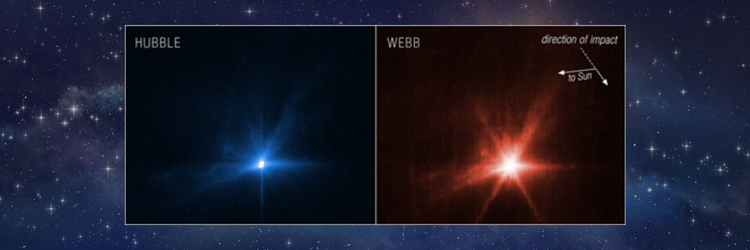Webb, Hubble Capture DART Impact Details
The James Webb Space Telescope and the Hubble Space Telescope captured views of a unique NASA experiment designed to intentionally smash a spacecraft into a small asteroid in the world’s first-ever in-space test for planetary defense. NASA’s Double Asteroid Redirection Test (DART) impact marks the first time that Webb and Hubble simultaneously observed the same space target.
On Sept. 26, 2022, at 7:14 pm EDT, DART intentionally crashed into Dimorphos, the asteroid moonlet in the double-asteroid system of Didymos. This impact represents the world’s first kinetic impact mitigation technique test, using a spacecraft to deflect an asteroid that poses no threat to Earth and modify the object’s orbit.
Webb and Hubble captured the impact in different wavelengths of light, Webb in infrared, and Hubble in visible.
Webb took one observation of the impact location before the collision, then several observations over the next few hours. Images from Webb’s Near-Infrared Camera (NIRCam) show a tight, compact core, with plumes of material appearing as wisps streaming away from the center of where the impact took place. Webb observed the impact over five hours total and captured ten images. The data was part of Webb’s Cycle 1 Guaranteed Time Observation Program 1245 led by Heidi Hammel of the Association of Universities for Research in Astronomy (AURA).
Hubble captured observations of the binary system ahead of the impact and 15 minutes after DART hit the surface of Dimorphos. Images from Hubble’s Wide Field Camera 3 show the crash in visible light. Ejecta appears as rays stretching out from the body of the asteroid. The bolder, fanned-out spike of ejecta to the left of the asteroid is in the general direction from which DART approached. In the Hubble images, astronomers estimate that the system’s brightness increased three times after impact and saw that brightness hold steady, even eight hours after.
Hubble plans to monitor the Didymos-Dimorphos system ten more times over the next three weeks for a complete picture of the cloud’s expansion from the ejection to its disappearance.
Hubble captured 45 images in the time immediately before and following DART’s impact with Dimorphos. The Hubble data was collected as part of Cycle 29 General Observers Program 16674.

